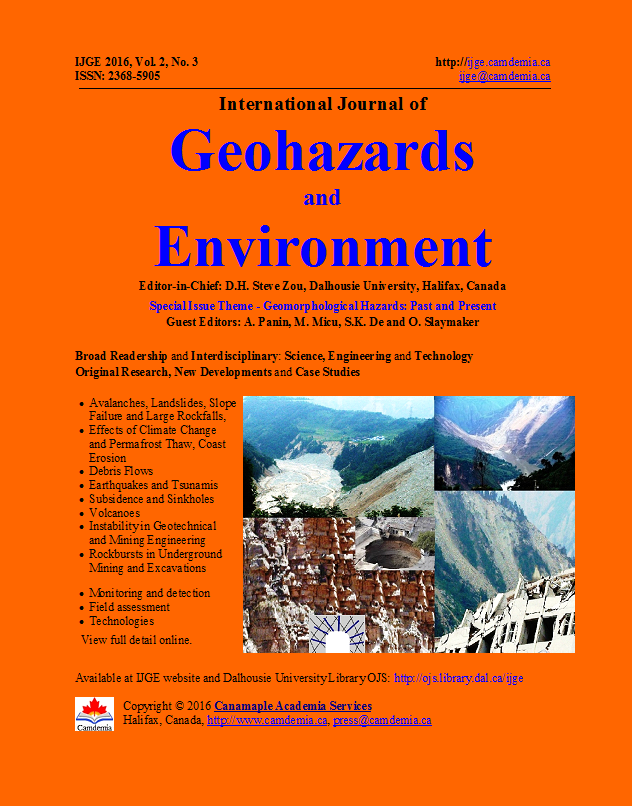Dating Strong Prehistoric Earthquakes and Estimating Their Recurrence Interval Applying Radiocarbon Analysis and Dendroseismological Approach – Case Study from SE Altai (Russia)
DOI:
https://doi.org/10.15273/ijge.2016.03.014Keywords:
geohazards, paleoseismicity, radiocarbon dating, dendroseismology, recurrence interval of strong earthquakes, Holocene, SE AltaiAbstract
Earthquakes are some of the most disastrous geohazards. The recurrence interval of strong earthquakes is a crucial characteristic for seismic hazard risk assessment. In this context absolute age determination of ancient earthquakes is one of the key problems. This paper presents the results of our geomorphological, paleoseismogeological, and geochronological investigations in seismically active southeastern part of Russian Altai. To specify the Holocene recurrence interval of strong earthquakes in the SE Altai we used radiocarbon and tree ring analysis. Twenty-five new radiocarbon ages were obtained for previously unknown effects of prehistoric earthquakes located near the southern fault boundary of the Chagan-Uzun massif and were reactivated during the 2003 Chuya earthquake. Results obtained argue for high regional seismicity in the second half of the Holocene and indicate the Chagan-Uzun massif to be one of the major seismogenic neotectonic structure within the SE Altai. Strong earthquakes occurred here about 600-700, 1,300-1,500, 2,400-2,700, and 3,400-3,700 and 3,800-4,200 cal. BP. Together with the previously published radiocarbon dates these data clarify the chronology of seismic events within the SE Altai. The specified recurrence interval of strong earthquakes for the SE Altai is about 400 years during the last 4,000 years. Numerous evidences of several seismic excitations were found in sediments from the largest landslide triggered by the 2003 Chuya earthquake. This argues for repeated activization of the same earthquake source zones in the SE Altai during the Holocene. Seismic activization of the fault boundaries of the Chagan-Uzun massif in the late Pleistocene-Holocene, as well as in 2003, was accompanied by its rotation counter clock-wise with the prevailing displacement along dextral strike-slip faults of NW direction. This is supported by results of our geomorphological investigations and previously unknown ground effects of the 2003 Chuya earthquake in the central part of the Chagan-Uzun massif.Downloads
Issue
Section
License
Copyright, Terms and Conditions
The International Journal of Geohazards and Environment (the Journal) is published by Canamaple Academia Services (the Publisher) online with open access, under a Creative Commons Attribution-Noncommercial license (CC-BY-NC) (http://creativecommons.org/licenses/by-nc/4.0/). Authors (the Authors) submitting papers (the Work) for publication in the Journal automatically agree to the following terms and conditions.
1. Under the license (CC-BY-NC), Authors give permission for others to share and reuse the Work, as long as the original source and author(s) are properly cited (i.e. a complete bibliographic citation and link to the Journal website) and the material is not used for commercial purposes. Any sharing or reuse must however indicate the original CC-BY-NC license terms of the work.
2. Authors transfer and assign to the Publisher all copyright in and to the Work. However Authors retain all proprietary rights except the copyright, related to the Work and also retain the rights a) to use, reproduce, distribute, and publicly display the Work in any medium in connection with the Authors‘ academic and professional activities, such as teaching, presentations and lectures, b) to create derivative works from the Work and to make full use of the Work in future research and publications, c) to authorize others to make any non-commercial use of the Work, d) to make both the pre-published and final-published versions available online in institutional and/or disciplinary repositories or on their own websites with a citation and link to the original paper published in the Journal.
3. Authors warrant that the Work is their original work, it is not copied from anywhere or anyone else, they are totally responsible for the authenticity, originality, validity and accuracy, and the facts and views are their own, that the Work contains no matter which is defamatory or infringes any literary or proprietary rights, intellectual property rights, or any rights of privacy, and that the Work has not been simultaneously submitted to any other journals or publishers. Authors further agree that their manuscripts whether accepted or rejected will not be returned and the rejected manuscripts will be disposed at the journal editor's discretion.
Disclaimer: The Publisher, the Journal and the editors accept no responsibility for statements or opinions expressed by authors. Use of information and materials in the Journal is the sole responsibility of users.


